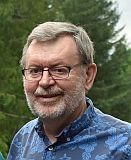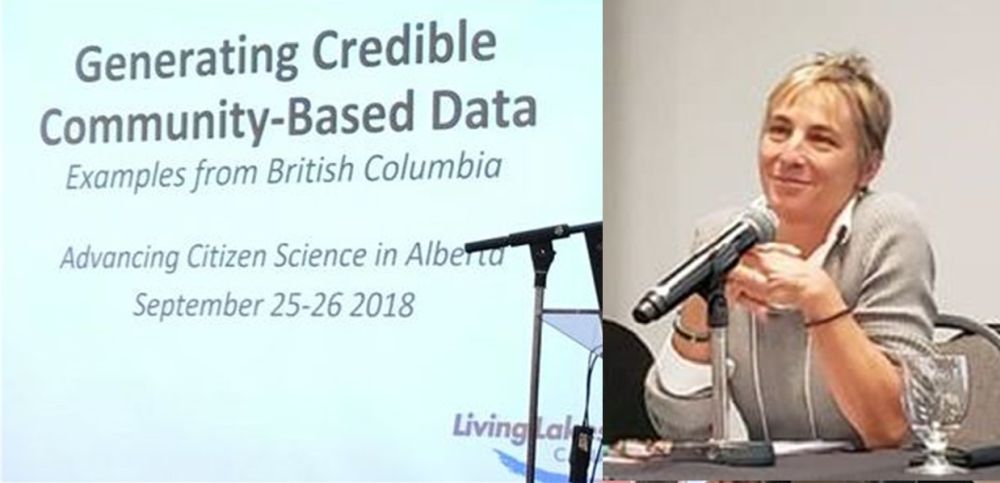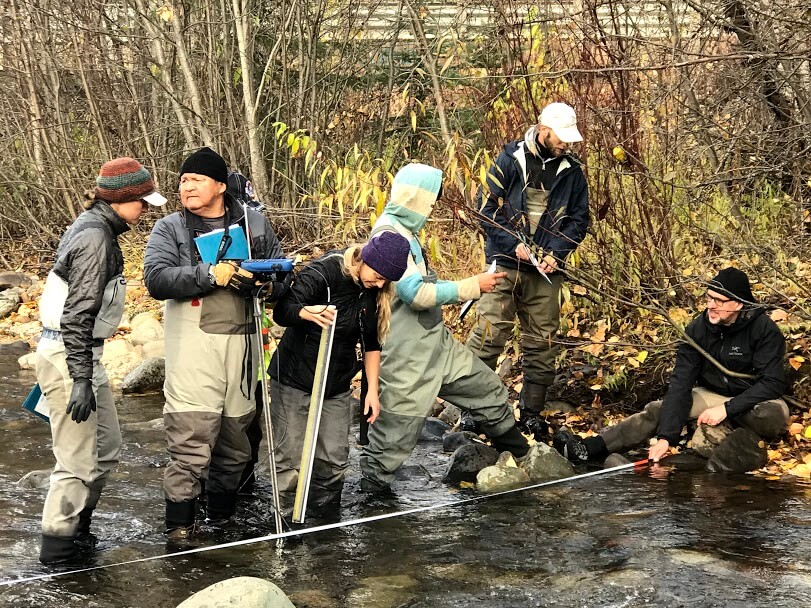LIVING LAKES CANADA – COLLABORATING TO PROTECT WATER IN A CHANGING CLIMATE: “If we don’t build this water balance approach to support subsequent water budgets, we’re not going to be prepared for what potentially could be an exponential drop in water supply,” states Kat Hartwig, Founder & Executive Director, Living Lakes Canada
Note to Reader:
Waterbucket eNews shares the stories of those who embrace “design with nature” approaches to reconnect people, land and water in altered landscapes. We celebrate the commitment, hard work and perseverance of individuals and groups who lead by example to make a difference for the common good.
In this edition, we showcase the outstanding work of Living Lakes Canada. We do so because this initiative is a shining example of collaboration between the stewardship and local government sectors. Based in the Columbia Basin region of British Columbia, Living Lakes Canada helps local governments by building grass-roots capacity to tackle local climate impacts through community-based water monitoring (CBWM).
EDITOR’S CONTEXT:
“Last October, I received an email enquiry from Nicole Trigg. She wondered whether the Partnership would be interested in profiling the proceedings of a hydrology workshop hosted by Living Lakes Canada. “Sure,” I replied, “especially if you could provide a story behind the story so that readers would say ‘Ah-ha, now I get it; and I understand why I should care’,” stated Kim Stephens, Waterbucket eNews Editor and Executive Director, Partnership for Water Sustainability in British Columbia.
 “Fast-forward to February 2020. A Zoom meeting with Nicole Trigg and Kat Hartwig lifted the veil on a compelling story about collaboration in action. The tool created by Living Lakes Canada is an open source Columbia Basin Water Hub. Sounds technical and boring, doesn’t it? That was my first reaction.”
“Fast-forward to February 2020. A Zoom meeting with Nicole Trigg and Kat Hartwig lifted the veil on a compelling story about collaboration in action. The tool created by Living Lakes Canada is an open source Columbia Basin Water Hub. Sounds technical and boring, doesn’t it? That was my first reaction.”
“However, the story behind the story is the passion of Kat Hartwig, human dynamo, and how her commitment and persistence brought a vision for citizen science to fruition. ‘Except,’ Kat said, ‘please don’t use the term citizen science!”
“The relevance of the Living Lakes story is that it points the way to re-framing citizen science as “community-based water monitoring”. The phrase is visual, conveys a story in a glance, and resonates. That is the essence of what I learned from Kat Hartwig. Filling a data gap and supporting local government started out as Kat’s game plan. Guided by her vision for community-based water monitoring, she and her Living Lakes team have created the Columbia Basin Water Hub. Now it is onwards and upwards!”
QUOTABLE QUOTE – Nicole Trigg, March 2020
 “Kat Hartwig is the passion and vision behind Living Lakes. At the same as she is building Living Lakes, Kat is also mentoring a growing team of young environmental professionals who are very passionate about water stewardship. Everyone wants to continue Kat’s vision. She is a true visionary. She is a mentor. Should Kat step away, the aim and goal are to continue what she started. The Living Lakes team is passionate, dedicated and continues to grow.”
“Kat Hartwig is the passion and vision behind Living Lakes. At the same as she is building Living Lakes, Kat is also mentoring a growing team of young environmental professionals who are very passionate about water stewardship. Everyone wants to continue Kat’s vision. She is a true visionary. She is a mentor. Should Kat step away, the aim and goal are to continue what she started. The Living Lakes team is passionate, dedicated and continues to grow.”


Kat Hartwig has been involved in international, national and regional environmental advocacy issues relating to sustainable tourism, endangered species, corporate social responsibility and water based ecosystem health since 1983. Kat continues to advocate for land and water policy and protection mechanisms necessary to support biodiversity, source water protection and climate resilient communities.
Re-frame “Citizen Science” as Community-Based Water Monitoring!
“Living Lake Canada is the Canadian partner of Living Lakes International — the global network of non-government organizations that share the mission to enhance the protection, restoration and rehabilitation of lakes, rivers, wetlands and watersheds throughout the world,” stated Nicole Trigg.
“After morphing from the Wildsight environmental group into Living Lakes Canada, an important next step for LLC was to facilitate and chair the East Kootenay Integrated Lake Management Partnership and the Kootenay Lake Partnership in the West Kootenay.”
Collaboration with First Nations, Governments and Others:
“Through these coalitions comprised of various agencies, local governments, First Nations and non-government organizations with joint responsibilities to protect lake ecosystems, LLC worked with Fisheries and Oceans Canada (DFO) to develop a Sensitive Habitat inventory Mapping (SHIM) methodology for 13 lakes in the Columbia Basin.”
“From there LLC worked with Environment & Climate Change Canada, becoming one of the first NGOs to be certified by the federal government to deliver field training for the Canadian Aquatic Biomonitoring Network (CABIN), the national biomonitoring protocol involving the collection of benthic macroinvertebrate samples to determine stream health.”
Leading-Edge Involvement in Biomonitoring Research:
“LLC is also partnering with WWF-Canada, University of Guelph and ECCC to deliver STREAM — short for Sequencing the Rivers for Environmental Assessment and Monitoring – a 3-yr biomonitoring project. This is a really high profile project to test a protocol using eDNA as a supplement for the CABIN protocol. The goal is to increase efficiencies for reduced cost and increased accuracy so we don’t have benthic samples being analyzed under a microscope, but rather through metabarcoding.”

Living Lakes Canada hosting an “Intro to FIMP fieldwork” day on Lake Windermere, one of the lakes surveyed using updated methodology developed in partnership with Fisheries and Ocean Canada to conserve sensitive lake foreshore habitat. FIMP is the acronym for Foreshore Inventory Management Planning
Living Lakes Canada had its genesis in the Lake Windemere Project in the East Kootenays region
“Located in the Columbia Valley region of southeastern British Columbia, Lake Windermere is a heavily-used body of water that is part of the Columbia Wetlands complex, a RAMSAR designated site and one of the longest remaining intact wetlands in North America,” continued Nicole Trigg.
“Wildsight had hosted the 2004 International Living Lakes conference in the Columbia Valley where delegates raised concerns about the sustainability of the Columbia Wetlands watershed and in particular Lake Windermere, where the burbot fishery had recently collapsed.”
A Template for Community Action:
“Funded by the Real Estate Foundation of BC, the aim of the five-year Lake Windermere Project was to involve both government and the public in the protection and enhancement of the lake and its surrounding watershed through interagency cooperation, public education and engagement, and scientific water quality monitoring.”
“The project successfully engaged all levels of Canadian government, First Nations and community members and, upon completion, became a template for other water monitoring groups operating in the Columbia Basin and elsewhere in Canada.”
“From its humble origins as a REFBC-funded water project to now a leading CBWM non-profit organization, LLC has experienced exponential growth since becoming its own registered charity in 2017 with a number of other projects completed and more under development,” concluded Nicole Trigg.

Living Lakes Canada Program Manager Raegan Mallison (centre, purple toque) leading a CABIN training session in Smithers, B.C. with representatives from Gitxsan Environmental Services, Gitanyow Fisheries Authority, Wetsuweten Fisheries, Skeena Fisheries, Lake Babine Fisheries and Eclipse Geomatics. CABIN is the acronym for the Canadian Aquatic Biomonitoring Network, the national biomonitoring protocol.
Living Lakes Canada: Collaborating to Protect Water in a Changing Climate
“We call it community-based water monitoring because it’s driven by community and by sense of place within community both for Indigenous and non-Indigenous stewardship initiatives,” explained Kat Hartwig, executive director for Living Lakes Canada, which co-convened the Community-Based Water Monitoring (CBWM) roundtable with WWF-Canada and the Gordon Foundation.
“In a national survey coordinated by Living Lakes Canada in partnership with Simon Fraser University and University of Acadia to see what groups were doing across the country, we found there had been an exponential growth in CBWM in Canada over 10 years. So we took that information and collaborated to hold the Roundtable.”
“We want to ensure that CBWM, which is rather sophisticated in some parts of Canada, does not get left behind and is acknowledged and built upon in this new Canada Water Agency. During this era of biodiversity crisis and climate crisis, we need all hands on deck if we’re doing to try and build resilience into our communities.”
“That’s really the impetus —water seems to be the most tangible way for people to understand climate impacts.”
“It was this premise that motivated Kat to switch her focus from environmental advocacy to water stewardship when she began working on the innovative Lake Windermere Project back in 2005 under the umbrella of the environmental group Wildsight,” added Nicole Trigg.
Leadership role played by Living Lakes Canada has influenced a national water initiative
One year before the federal government mandated the creation of the Canada Water Agency (CWA), a National Roundtable discussion around Community-Based Water Monitoring (CBWM) in Canada took place in November of 2018 in Ottawa.
CBWM Explained:
A type of scientific and Traditional ecological data collection led by Indigenous and non-Indigenous community and/or non-governmental organizations, CBWM powerfully engages Canadians in managing and protecting fresh water while democratizing data and incentivizing citizens to steward their local waters.
2018 Roundtable – Outcomes:
The roundtable brought together more than 50 leading Indigenous and non-Indigenous CBWM leaders, water scientists and policy experts from across Canada.
The roundtable purpose was to identify actionable steps the federal government could take to legitimize the growing trend of community-based monitoring of freshwater ecosystems, and to support sustainable long-term CBWM programs.
The National Roundtable made 60 recommendations. These were then distilled down to four key priority actions, which the CBWM coalition has presented to the minister responsible for Environment and Climate Canada (ECCC) for inclusion in the CWA as part of the ongoing public consultation process.

An open source data hub dialogue towards a Columbia Basin Water Monitoring Framework, Invermere, BC. Living Lakes Canada co-hosted a conference in 2017 to envision a Water Monitoring Framework and open source data hub for the Columbia Basin.
Stewardship Sector Collaboration with Local Government
“There was a perception that the lake wasn’t as healthy as it used to be, and that’s what spawned the Lake Windermere Project, which was funded by the Real Estate Foundation of BC,” recounted Kat.
“The Lake Windermere Project won the inaugural REFBC Lands Award in 2010. Stewardship of the lake was taken over by the local community through the Lake Windermere Ambassadors Society, which is still going strong over 10 years later, and that was the start of Living Lakes Canada with a focus to normalize water stewardship through community based water monitoring.”
Lake Management Planning
“That got us deeply involved in the science of water stewardship, and we began partnering with the BC Lake Stewardship Society, which then morphed into several projects using federal and provincial scientific standards. We’re now upgrading Sensitive Habitat inventory Mapping (SHIM) with DFO to modernize the methodology – today known as Foreshore Inventory Management Planning or FIMP – and applying it to priority lakes.”
“It’s a really important tool to designate zoning around lakes based on the sensitivity of the foreshore which allows lake management plans to be developed and incorporated into Official Community Plans.”

Volunteer well owners in Living Lakes Canada’s Columbia Basin Groundwater Monitoring Program view water level data from their well via a free app.
Filling Water Data Gaps
“While our programming has grown to extend across BC and Canada, LLC continues to operate primarily in the Upper Columbia Basin (UCB), where climate change impacts and the need for increased water monitoring to fill important data gaps have been well documented in several studies over the past decades,” stated Nicole.
“One of the things we were interested in was looking at how we could fill those data gaps and how we could support local government and Indigenous water monitoring priorities because there are such limited resources for collecting and sharing data,” continued Kat.
“For example, the Provincial Groundwater Observation Well Network has 219 observation wells across the Province, of which only six are in the UCB, so we developed the Columbia Basin Groundwater Monitoring Program to collect more local knowledge about groundwater through partnerships with existing well owners. There are now an additional 20 groundwater observation wells in the UCB that are collecting long-term water level data.”
Columbia Basin Water Hub
“In response to a 2017 Columbia Basin Trust report that pointed to the need for a coordinated monitoring effort and central data repository in the UCB, LLC organized a conference in late 2017 that was attended by water data experts from across North America who discussed the democratization of data, the merits of open source, and the need for a water monitoring framework for the region,” added Nicole.
“So we set out to build an open source data hub for the UCB,” continued Kat. “Now we’ve got the platform built, we’re training groups to upload their data, and we’re receiving feedback from groups and provincial and local governments to ensure we’re supporting their needs. It’s an iterative process. The data is being quality controlled using metadata standards provided by a scientific sub-committee that align with the Province.”
“Then, to lay the groundwork for a water monitoring framework, LLC convened a meeting last summer of senior hydrologists from government, consultants and academia who arrived at the consensus that a water balance approach was needed to fill the water data gaps in the UCB’s 10 sub-watersheds.”
Water Balance Approach
“Most recently (June 2020), the University of British Columbia published a 30-year study suggesting the glacier-melt contributions to runoff have already passed peak water for summer stream flows in the Canadian Columbia Basin,” Nicole pointed out.
“The concern is that if we don’t build this water balance approach to support subsequent water budgets, we’re not going to be prepared for what potentially could be an exponential drop in water supply,” Kat emphasized.
“I think it’s full circle. Had we not had the Real Estate Foundation of BC backing our original CBWM vision, I don’t think we’d have been given the legitimacy that we needed to involve multi-sectors as stakeholders in our stewardship work and grown it to where it is today.”
“We’re blithely going along while we’re having exponential changes and that’s not going to bode well for adaptation. We need to make sure that we’re working collaboratively and not in silos, and not allow the problem of our multi-jurisdictional gridlocks to foist the huge onus and fiduciary responsibility of water supply and protecting ecosystems onto small community governments,” concluded Kat.

Columbia Basin Water Hub
Set to formally launch in March 2021, the Columbia Basin Water Hub will make critical water data readily available to decision makers for watershed management in an era of climate change impacting hydrological flows.
Datasets from the FIMP methodology that Living Lakes Canada is updating with DFO will also be stored on the Water Hub. The open source platform is a model for other regions in BC and across Canada.
To lay the groundwork for a framework, in June 2020 Living Lakes Canada convened a meeting of senior hydrologists from government, academia and Global Water Futures who together arrived at the consensus that a water balance approach would be the most effective for filling data gaps in the UCB’s 10 sub-watersheds.
In February 2021, Kat Hartwig was a panelist for the Canada Water Agency BC Regional Forum, where she presented on the Columbia Basin Water Hub and the water challenges facing the UCB region, and discussed the supportive role the Canada Water Agency could take in helping solve them.
To Learn More:
http://livinglakescanada.ca/wp-content/uploads/2020/10/LLC-wm-wkshp_prcdngs-final_Oct-08-2020.pdf



